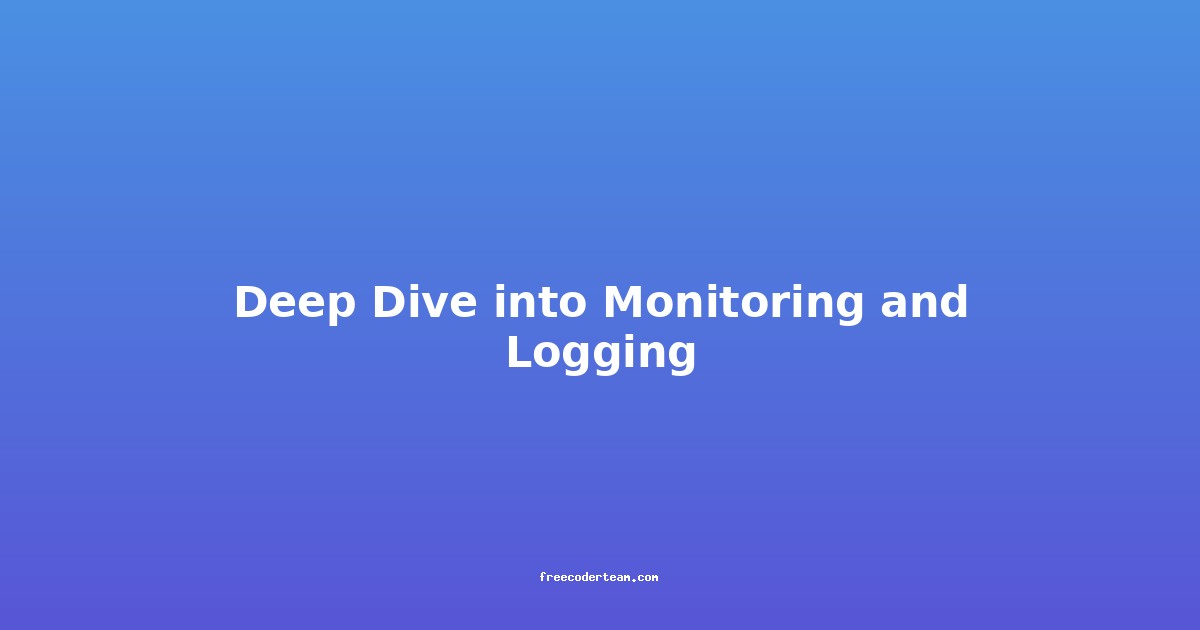Deep Dive into Monitoring and Logging: Best Practices and Practical Insights
Monitoring and logging are critical components of modern software systems. They provide visibility into system behavior, help diagnose issues, and ensure reliability. In this deep dive, we’ll explore the fundamentals of monitoring and logging, discuss best practices, and provide actionable insights with practical examples.
Table of Contents
- Introduction to Monitoring and Logging
- Key Components of Monitoring
- Metrics
- Events
- Traces
- Logging Best Practices
- Structured vs. Unstructured Logging
- Log Levels and Message Formats
- Centralized Logging
- Monitoring Tools and Technologies
- Prometheus and Grafana
- ELK Stack (Elasticsearch, Logstash, Kibana)
- Practical Examples
- Monitoring a Microservice with Prometheus
- Logging Request Details in Python
- Actionable Insights
- Conclusion
Introduction to Monitoring and Logging
Monitoring and logging are often used interchangeably, but they serve distinct purposes:
- Logging involves capturing detailed information about system events, errors, and activities. Logs provide a historical record of what happened and why.
- Monitoring involves collecting and analyzing metrics, events, and traces in real-time to detect anomalies and ensure system health.
Together, they form the foundation for observability, which is the ability to understand the internal state of a system through external outputs.
Key Components of Monitoring
Monitoring is typically broken down into three core components:
1. Metrics
Metrics are quantitative measurements that describe system behavior over time. Examples include CPU usage, memory consumption, request latency, and error rates.
Example
# Example of collecting metrics in Python
from prometheus_client import Counter, Gauge
REQUEST_COUNTER = Counter('http_requests_total', 'Total HTTP requests', ['method', 'endpoint'])
LATENCY_GAUGE = Gauge('http_request_latency_seconds', 'HTTP request latency in seconds')
def handle_request(method, endpoint):
start_time = time.time()
# Process request...
REQUEST_COUNTER.labels(method=method, endpoint=endpoint).inc()
LATENCY_GAUGE.set(time.time() - start_time)
2. Events
Events are discrete occurrences that happen at a specific point in time. Examples include server restarts, configuration changes, or critical errors.
Example
{
"timestamp": "2023-10-01T12:00:00Z",
"event_type": "server_restart",
"server_id": "app-server-1",
"details": {
"reason": "Scheduled maintenance"
}
}
3. Traces
Traces capture the flow of a request through a distributed system, helping to understand how different services interact. They are essential for debugging complex microservice architectures.
Example
Trace ID: 1234567890abcdef
Span 1: HTTP Request (GET /api/users)
Duration: 100ms
Attributes: {
method: "GET",
endpoint: "/api/users",
status_code: 200
}
Span 2: Database Query (SELECT * FROM users)
Duration: 50ms
Attributes: {
query: "SELECT * FROM users",
rows_affected: 10
}
Logging Best Practices
Effective logging is crucial for debugging, auditing, and troubleshooting. Here are some best practices:
1. Structured vs. Unstructured Logging
- Structured Logging: Logs are formatted as key-value pairs, making them easy to parse and analyze programmatically.
- Unstructured Logging: Logs are plain text, which can be harder to process but may be more human-readable.
Example of Structured Logging in Python
import logging
logger = logging.getLogger(__name__)
def process_request(user_id, request_type):
logger.info({
"action": "process_request",
"user_id": user_id,
"request_type": request_type,
"status": "success"
})
2. Log Levels and Message Formats
Use standardized log levels (DEBUG, INFO, WARNING, ERROR, CRITICAL) and ensure messages are concise and meaningful.
Example of Log Levels in Python
import logging
logger = logging.getLogger(__name__)
def handle_error(exception):
logger.error(f"An error occurred: {str(exception)}", exc_info=True)
3. Centralized Logging
Centralize logs in a single location (e.g., Elasticsearch) for easier search, aggregation, and analysis.
Example of Centralized Logging with Logstash
input {
beats {
port => 5044
}
}
output {
elasticsearch {
hosts => ["localhost:9200"]
}
}
Monitoring Tools and Technologies
Several tools and technologies are commonly used for monitoring and logging:
1. Prometheus and Grafana
Prometheus is an open-source monitoring system that collects metrics and alerts on anomalies. Grafana is a visualization tool that displays these metrics in dashboards.
Example of Setting Up Prometheus
# prometheus.yml
scrape_configs:
- job_name: 'node_exporter'
static_configs:
- targets: ['localhost:9100']
Example of Grafana Dashboard
Grafana allows you to create interactive dashboards to visualize metrics. For example, you can create a dashboard to monitor CPU usage, memory consumption, and request latency.
2. ELK Stack (Elasticsearch, Logstash, Kibana)
ELK is a popular stack for centralized logging. It allows you to collect, process, and analyze logs in real-time.
Example of ELK Stack Architecture
- Logstash: Collects and processes logs.
- Elasticsearch: Stores and indexes logs for fast retrieval.
- Kibana: Provides a GUI for visualizing and analyzing logs.
Practical Examples
1. Monitoring a Microservice with Prometheus
To monitor a microservice, you can expose metrics via an HTTP endpoint and scrape them using Prometheus.
Example of Exposing Metrics
from prometheus_client import start_http_server, Counter
REQUEST_COUNTER = Counter('http_requests_total', 'Total HTTP requests', ['method', 'endpoint'])
def handle_request(method, endpoint):
REQUEST_COUNTER.labels(method=method, endpoint=endpoint).inc()
if __name__ == '__main__':
start_http_server(8000) # Expose metrics on port 8000
# Run your application...
Prometheus Configuration
scrape_configs:
- job_name: 'microservice'
static_configs:
- targets: ['localhost:8000']
2. Logging Request Details in Python
Logging request details can help diagnose issues in a web application.
Example of Logging Request Details
import logging
logger = logging.getLogger(__name__)
def log_request(request):
logger.info({
"action": "http_request",
"method": request.method,
"endpoint": request.path,
"status_code": request.status_code,
"duration": request.elapsed.total_seconds()
})
Actionable Insights
- Define Key Metrics: Identify what you need to monitor (e.g., response time, error rates) and measure them consistently.
- Use Structured Logging: Always log in a structured format to enable easy parsing and analysis.
- Centralize Logs: Avoid having logs scattered across different servers or services. Use tools like ELK or Splunk to centralize them.
- Set Up Alerts: Configure alerts for critical metrics (e.g., high CPU usage, slow request times) to proactively address issues.
- Monitor Distributed Systems: Use tracing tools like Jaeger or Zipkin to trace requests through microservices.
Conclusion
Monitoring and logging are essential for building reliable and maintainable systems. By understanding the key components of monitoring (metrics, events, traces) and following best practices in logging, you can gain deep insights into your system’s behavior.
Tools like Prometheus, Grafana, and the ELK Stack provide powerful capabilities for collecting, analyzing, and visualizing data. By implementing these practices and leveraging the right tools, you can ensure your systems are observable, resilient, and ready to handle any challenge.
References:
Feel free to reach out if you have any questions or need further clarification!




